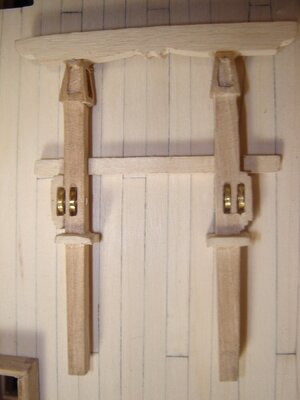This is going to be kind of impossible to answer but I'll give it a shot. I just bought a couple of Dremel 1/16" end mills (1/8" shank) and I've never used anything this small. Considering the size did you find this small stuff surprisingly weak or strong? I'm trying to cut slots for sheaves(sp?) in the jeer bitts and I'm so chicken it will take forever to cut all the slots. Does anyone have any hints as to how deep a cut or feed rates a guy can get away with.
-

Win a Free Custom Engraved Brass Coin!!!
As a way to introduce our brass coins to the community, we will raffle off a free coin during the month of August. Follow link ABOVE for instructions for entering.
You are using an out of date browser. It may not display this or other websites correctly.
You should upgrade or use an alternative browser.
You should upgrade or use an alternative browser.
Truth be told, they work right up until you snap it off, then you know what you can get away with. You have to go by feel when you mill with manual feed, which CNC guys don't have. Better to go too slow and make a clean cut than get impatient and start breaking bits. With that size bit, you should be able to mill your basic hardwood to a depth equal to the diameter of the bit at a fairly slow speed safely without tearing the wood or breaking the bit. You will add speed or depth based on feel. Avoid any bend in the bit as you cut. That means you're getting dangerously close to hearing a snapping sound and gouging the wood.
Thanks that's a help. I forgot to mention that I'm using a full sized milling machine and it looks like 2400(yes two zeros)rpm is the best I can do. I bought two end mills so I get one mistake
- Joined
- Aug 8, 2019
- Messages
- 5,488
- Points
- 738

The cutter breaks when you see it begin to bend in the wood. You are too deep or moving it too fast. Also if you see smoke or it is obvious that it is getting too hot. What is important is that such a small router needs a high RPM. I recommend at least 10,000 min¹. That's what I do. Hope I gave some help
Hi Don,
I would agree with Kurt and Stehpan.
I would add that 2400 rpm will be fine, faster would be good as well but not essential. As for feed rate if the wood is burning you are going too slow or the cutter is blunt. You want to be feeding at a reasonable pace. These sort of cutters are designed to cut steel and won't have any trouble cutting wood.
An End mill is a bit stronger than a Slot drill but it won't clear the chips as well, I would suggest using compressed air to blow out the chips, you shouldn't need much more than 20 or 30 PSI or 2 Bar in pressure, or a vacuum cleaner to suck out the chips and wear safety glasses.
Cheers,
Stephen.
I would agree with Kurt and Stehpan.
I would add that 2400 rpm will be fine, faster would be good as well but not essential. As for feed rate if the wood is burning you are going too slow or the cutter is blunt. You want to be feeding at a reasonable pace. These sort of cutters are designed to cut steel and won't have any trouble cutting wood.
An End mill is a bit stronger than a Slot drill but it won't clear the chips as well, I would suggest using compressed air to blow out the chips, you shouldn't need much more than 20 or 30 PSI or 2 Bar in pressure, or a vacuum cleaner to suck out the chips and wear safety glasses.
Cheers,
Stephen.
Spend a little time reading about 'Speeds and Feeds'. There are charts for milling and pages outlining the better RPM settings for milling wood. Some suggest speeds at 15000 RPM or above. Also think about how CNC routers do their jobs. High speed end mills can take it.
What I meant by SLOW is slow lateral movement, not RPM. RPM is kept rather high. RPM too high and cutting action is reduced and heat is generated. If RPM is too slow, and cuts are deep but force on the bit since it is biting deeper into the wood and trying to remove too much too fast, and you can tell because the cuts are ragged and not smooth. I suggest practicing on a similar piece of scrap wood until you see the cuts are being made easily and smoothly with no burning or tearing. You are looking for a balance of speed, feed and correct depth and you learn that by simply doing it on scraps first. Always use sharp bits. Dull ones tell you they are dull buy scorching the wood. You'll find the right settings rather fast.
Nice result Don,Thanks Guys. I managed to cut these slots. It took about five passes per slot. The wood is Hazel. I did have to lengthen them and square off the corners with a file. I have to learn how to measure a little betterView attachment 299698
Cheers,
Stephen.
Thanks Stephan This was one of those parts that was very dirty when it was finished because I had to handle it so much. Very satisfying though.Nice result Don,
Cheers,
Stephen.



